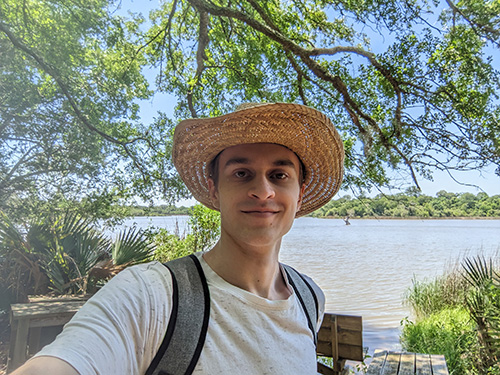Stars aligned for alumnus’ career in aerospace industry

One Clear Horizons Early College High School student gave his professor something many educators hope for — seeing students transform from the classroom to a career they love.
Gabriel Braun consistently submitted work ahead of deadlines, read directions carefully, and asked for feedback on his work. To Cristina Cardenas, San Jacinto College speech professor, he showed great potential.
“His willingness to learn from his mistakes and not repeat them was very impressive,” Cardenas said. “Not everyone has the ability to do this at such a young age.”
During Braun’s time at Clear Horizons, networking was a boon to his future.
Connecting the dots
Cardenas’ husband coincidentally became Braun’s mentor, guiding him into a software engineering career at NASA’s Johnson Space Center.
The curriculum included a one-semester internship for which Braun had to find a mentor in his field of interest. Both Braun’s parents are engineers at Johnson Space Center, and his dad introduced him to Ramirez.
“I first got involved with Clear Horizons through Gabriel,” said Daniel Ramirez, software engineering senior technical professional for KBR. “Gabriel is my former cow
orker’s son. He contacted me because he knew I had degrees in computer and software engineering, and computer science was a career interest to Gabriel.”
With encouragement from Cardenas, Ramirez, and his parents, Braun had a s
olid support system into the next phase of his life — the pursuit of career happiness.
To the moon and back

During the internship, Braun and Ramirez developed a three-degree-of-freedom launch trajectory simulation of a vehicle launching from Earth into space and back. This activity sparked a deeper interest in software engineering and led to Braun pursuing his current position.
He graduated from San Jac in 2019 with an Associate of Science degree in mathematics and went on to earn a bachelor’s degree in computer engineering fro
m the University of Texas at Dallas. Today, Braun works as a software engineer for CACI, a Johnson Space Center contractor, supporting the Gateway program, part of the Artemis program, which will take humans back to the moon.
“The Gateway program aims to revolutionize spaceflight operations through the introduction of autonomy,” Braun said.
The Gateway is a lunar space station that will orbit the moon and serve as an important outpost for lunar missions and as a staging point for deep-space exploration. In Braun’s work, one important component of Gateway is the vehicle system manager, an autonomous system that manages the Gateway, like a self-sustaining mission control.
He is eager to develop tools that could aid in things like simulations and scientific demonstrations. Braun believes the vehicle systems manager is going to be a “big change that could potentially help a lot of people in the future.”
“I didn’t have an interest specifically in aerospace, but there was an intersection between my interest in developing helpful too
ls for others and NASA creating an autonomous space station,” Braun said. “It’s an exciting time for the space program, and I’m honored to be part of the future of space exploration.”
What is to come
Although Braun is a working professional, the learning experience is far from over.
“San Jac helped me by kickstarting my college education at an earlier age, which ultimately saved me time and money while studying for my bachelor’s degree,” he said.
Within the next five years, Braun plans to earn a master’s degree in software engineering from the University of Houston-Clear Lake.
“I hope to continue my education indefinitely as long as I have the time and the resources,” he said. “My career goals are to become a subject matter expert in software and to continue supporting the Gateway program while it is in lunar orbit.”
